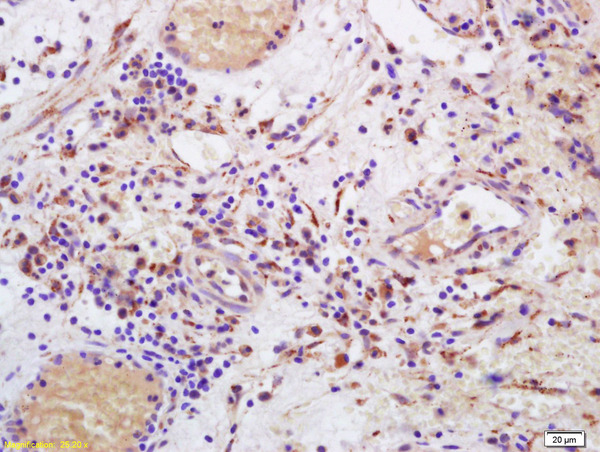KIR2DL4 antibody [mAb#33] (APC)
GTX80038-07
ApplicationsFlow Cytometry
Product group Antibodies
ReactivityHuman
TargetKIR2DL4
Overview
- SupplierGeneTex
- Product NameKIR2DL4 antibody [mAb#33] (APC)
- Delivery Days Customer9
- Application Supplier NoteFACS: 10 microl reagent / 100 microl of whole blood or 106 cells in a suspension. *Optimal dilutions/concentrations should be determined by the researcher.Not tested in other applications.
- ApplicationsFlow Cytometry
- CertificationResearch Use Only
- ClonalityMonoclonal
- Clone IDmAb#33
- ConjugateAPC (Allophycocyanin)
- Gene ID3805
- Target nameKIR2DL4
- Target descriptionkiller cell immunoglobulin like receptor, two Ig domains and long cytoplasmic tail 4
- Target synonymsCD158D, G9P, KIR-103AS, KIR-2DL4, KIR103, KIR103AS, killer cell immunoglobulin-like receptor 2DL4, CD158 antigen-like family member D, KIR2DL4 Killer-cell Immunoglobulin-like Receptor, KIR2DL4*00102, KIR2DL4*00103, KIR2DL4*00501, KIR2DL4*00801, KIR2DL4*00802, KIR2DL4*01101, KIR2DL4*021, KIR2DL4*022, KIR2DL4_00201, KIR2DL4_00201 protein, MHC class I NK cell receptor KIR103AS, killer cell immunoglobulin-like receptor, two domains, long cytoplasmic tail, 4, killer cell inhibitory receptor 103AS
- HostMouse
- IsotypeIgG1
- Protein IDQ99706
- Protein NameKiller cell immunoglobulin-like receptor 2DL4
- Scientific DescriptionKiller cell immunoglobulin-like receptors (KIRs) are transmembrane glycoproteins expressed by natural killer cells and subsets of T cells. The KIR genes are polymorphic and highly homologous and they are found in a cluster on chromosome 19q13.4 within the 1 Mb leukocyte receptor complex (LRC). The gene content of the KIR gene cluster varies among haplotypes, although several framework genes are found in all haplotypes (KIR3DL3, KIR3DP1, KIR3DL4, KIR3DL2). The KIR proteins are classified by the number of extracellular immunoglobulin domains (2D or 3D) and by whether they have a long (L) or short (S) cytoplasmic domain. KIR proteins with the long cytoplasmic domain transduce inhibitory signals upon ligand binding via an immune tyrosine-based inhibitory motif (ITIM), while KIR proteins with the short cytoplasmic domain lack the ITIM motif and instead associate with the TYRO protein tyrosine kinase binding protein to transduce activating signals. The ligands for several KIR proteins are subsets of HLA class I molecules; thus, KIR proteins are thought to play an important role in regulation of the immune response. This gene is one of the framework loci that is present on all haplotypes. Alternate alleles of this gene are represented on multiple alternate reference loci (ALT_REF_LOCs). Alternative splicing results in multiple transcript variants, some of which may not be annotated on the primary reference assembly. [provided by RefSeq, Jul 2016]
- ReactivityHuman
- Storage Instruction2°C to 8°C
- UNSPSC12352203
References
- Zheng G, Guo Z, Li W, et al. Interaction between HLA-G and NK cell receptor KIR2DL4 orchestrates HER2-positive breast cancer resistance to trastuzumab. Signal Transduct Target Ther. 2021,6(1):236. doi: 10.1038/s41392-021-00629-wRead this paper




